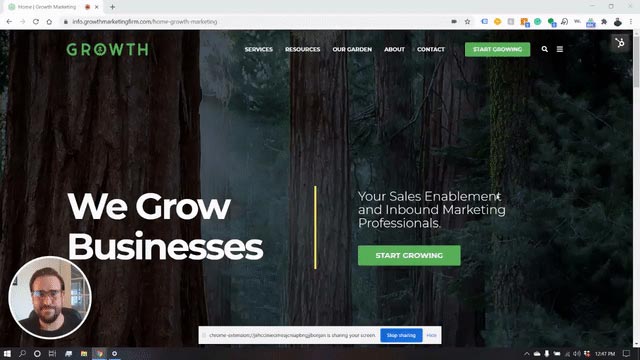The New Customer Success Metrics
Everyone knows that it costs more to gain new customers than it does to just keep the ones you have. But how do you know if you’re keeping your customers delighted? With data that measures relationship building.
Here are the top 10 data points you’ll need to watch (and how to calculate them) to make sure customers are happy. With these, you can build custom reports in your HubSpot CRM to make sure you’ve always got your eye on it.
.png?width=1200&name=customer-success-handshake-growth-marketing-firm%20(1).png)
Net Promoter Score (NPS)
NPS is a qualitative AND quantitative customer satisfaction benchmark that tells you how likely your customers are to recommend your business to their friends and family.
Your NPS is determined by asking your customers to rank their experience with your business on a scale of 1 to 10, but it also asks them to give a short explanation of their answers. This way, you can gather data that is more accurate because you can identify abnormal or outlying results.
You can simplify this process by creating workflow automations in HubSpot that are triggered by customer actions on your website (like a completed purchase) that open a form that basically says: “On a scale of 1 to 10, how likely are you to recommend this product or service?”
Add an open-ended section to your form that asks your customers to explain their answer.
HubSpot then gathers the data for you. Easy ™.
Customer Satisfaction Score
The Customer Satisfaction Score (CSAT) is similar to the Net Promoter Score, but it asks customers to rank their satisfaction with your company overall versus their likelihood to recommend it to a friend.
It’s basically a snapshot of a customer’s experience with customer service, and it requires a survey form that triggers directly after a customer service interaction to gather the data needed to calculate it.
The calculation is as follows:
- Divide the number of positive scores (at least a 6 out of 10) by the total number of scores you captured.
- Multiply your result by 100.
This percentage tells you the average number of customers who are happy with their experience with your brand.
Customer Effort Score
Is it difficult for your customers to get the help they need? If so, you need to know and adjust.
96% of customers who experience things like pre-recorded menu options, getting transferred from one agent to another, and other roadblocks to assistance say they’re likely to be disloyal even to a brand they love.
Percentages like that are what makes this score one of the most important for you to know as a business owner.
Your Customer Effort Score, or CES, can be determined by creating automated post-service surveys for your customers that rank their service on a scale from 1 to 10.
HubSpot can generate data like this automatically and automate a report for your dashboard.
Customer Churn Rate
.png?width=1920&name=customer-relationship-building-growth-marketing-firm%20(1).png)
Customer support reps and client-facing team members that build relationships with customers and clients have lower churn rates. When churn rates are high, this is an opportunity to coach your team on relationship building.
To determine churn rate:
- Choose a timeframe to measure.
- Note the number of customers you have & how many are lost during this time period.
- Divide the number of customers you lost by the number of customers you have (omit any new customers you acquired during this time period).
Qualitative Customer Feedback
Building a positive relationship with your customers involves giving them a voice to express openly what they love about your product or service. Here are a few great ways to do that:
- Create forms and surveys that ask open-ended questions that invite honest feedback.
- Watch and respond quickly to the comment section of your social media channels using HubSpot’s Social CRM.
- Host a “customer day” and invite customers to your headquarters to talk with you and your team.
This builds strong bonds between your customers and your brand.
Keep track of anecdotal customer information you gather through activities like these in HubSpot CRM so that you can continue to engage customers with consistency.
Monthly Recurring Revenue (MRR)
Monthly Recurring Revenue, or MRR, is a metric that shows you how much money your customers spend on your products and services for each given month.
This value gives you a good indication over time as to whether or not your customers are finding value in your products and services.
SaaS companies and subscription service businesses find this metric exceedingly helpful.
To calculate MRR, multiply the number of your monthly customers by your average revenue per user. This tells you how much money you’re generating per month.
Customer Lifetime Value
CLV tells you how much total revenue a single customer generates during the entire life of their relationship with your business. It’s a fundamental metric to understanding customer success, and fluctuations can tell you a great deal about how well your customer success teams are doing.
A downward trend can help you quickly pivot and shift your approach to relationship-building in order to retain your customer base.
To figure CLV:
- Multiply your average purchase value by your average purchase frequency rate.
- Multiply that number by your average customer lifespan.
The sum represents the estimated amount of revenue that one customer will spend on your business.
Customer Retention Cost
Your customer retention cost, or CRC, tells you the ROI of your customer success programs. By measuring CRC, you can make data-driven decisions about those programs that help support your business overall.
To calculate your CRC, audit the total expense of your customer service, including:
- Customer service & success payroll
- Engagement & adoption programs
- Professional services & training
- Customer marketing
Add these costs to one sum, then divide that sum by the number of customers you have.
First Contact Resolution Rate
In the world of customer experience, wait time is friction that keeps your business from growing. The more time it takes for your customer to get the help they need, the more likely they are to be lost to a competitor. Therefore, measuring the First Contact Resolution Rate is key.
To calculate this metric, divide the number of service tickets that are closed after the first interaction by the total number of service cases your team received. HubSpot Service Hub can provide this data through its tools for ticketing and help desk support. That way, you don’t have to crunch these complicated numbers.
As a HubSpot Platinum Solutions Partner, Growth is able to provide our customers with an exceptional experience from beginning to end. Want to know how we do it? Ask us! 
Explore More Insights: Related Blog Posts
-
 Inbound MarketingOct 21, 2021
Inbound MarketingOct 21, 2021 Growth Marketing Firm
Growth Marketing FirmGrowth Marketing Firm Continues 5 Star Rating Streak with Latest Review
Our team of experts at Growth helps our clients maneuver new processes and learn from the challenges they...
-
 Inbound MarketingJan 29, 2021
Inbound MarketingJan 29, 2021 Growth Marketing Firm
Growth Marketing FirmWhat is a Growth Agency?
A growth agency goes beyond traditional marketing objectives; offering tools and strategies to help your...
-
 Sales EnablementJan 28, 2022
Sales EnablementJan 28, 2022 Growth Marketing Firm
Growth Marketing FirmMeet Ross: Growth Design + Development Lead
Ross Goodman’s designs are one of the top benefits of working with Growth. In addition to building beautiful,...
-
 Sales EnablementMay 6, 2020
Sales EnablementMay 6, 2020 Growth Marketing Firm
Growth Marketing FirmBooming and Blooming with Growth: Our April Recap
To my marketers, business owners, and operators – thank you! I want to share with you the successes of our...
-
 Inbound MarketingAug 25, 2020
Inbound MarketingAug 25, 2020 Growth Marketing Firm
Growth Marketing FirmGrowth Update: August 2020
Thank you for taking the time to read more about our transition over the past few months. Whether you are a...
-
 Company CultureOct 11, 2021
Company CultureOct 11, 2021 Growth Marketing Firm
Growth Marketing FirmBehind the Growth Brand
A brand is more than just a logo, a combination of colors, or an image. A strong brand mirrors everything you...
-
 Inbound MarketingAug 27, 2021
Inbound MarketingAug 27, 2021 Growth Marketing Firm
Growth Marketing FirmGrowth Marketing Firm’s First Clutch Review: Five Stars!
At Growth Marketing Firm, we help businesses accelerate growth through results-driven digital solutions....
-
 Sales EnablementMar 23, 2020
Sales EnablementMar 23, 2020 Growth Marketing Firm
Growth Marketing FirmIntroducing Will Davidson: Our New Business Development Lead
My name is Will Davidson and I'm Growth Marketing Firm's new Business Development Lead! I'm uber excited to...
-
 Inbound MarketingSep 30, 2021
Inbound MarketingSep 30, 2021 Growth Marketing Firm
Growth Marketing FirmUpCity: Growth Shines Brightest Among Agencies Nationwide
Growth Marketing Firm is proud to announce that we have been recognized as one of the top marketing companies...
